I’m going to be straight and reveal the bottom line at the top: Dia de Muertos or Day of the Dead festivity in Mexico is possibly the most vibrant, cheerful and artful cultural event you’ll ever experience in your life. This wonderfully evocative holiday (October 31 to November 2) is celebrated throughout Mexico and despite its name, the activities span several days or even weeks depending on the region. If you are visiting Mexico City around this time, you will be able to experience some of the most colorful and elaborate icons encompassing Dia de Muertos.
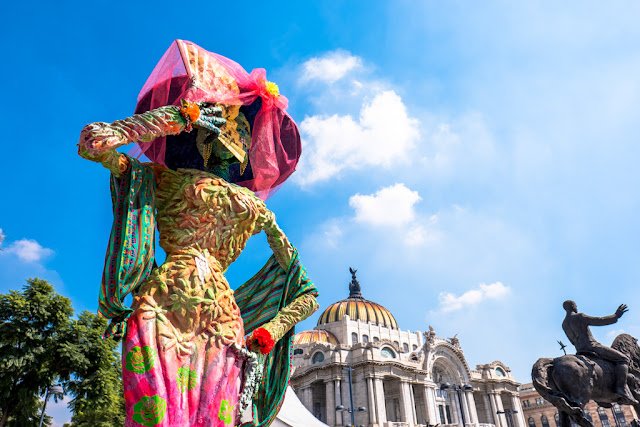
Admittedly, I can barely scratch the surface in a grand attempt to help you guide through this unique Mexican tradition, the symbols that surround Day of the Dead, and where you can witness them in Mexico City, but let me try my best in the following sections.
Jump to:
- What is Day of the Dead?
- Ofrendas, the centerpiece of Day of the Dead
- Who is La Calavera Catrina —The Skeleton Dame
- Let’s not neglect Santa Muerte —The Saint of Death
- Dead, like real dead —Mummies of Museo de El Carmen
- How (not) to chase Alebrijes —The Mythical Creatures
- How to attend the Day of the Dead Parade in Mexico City
- Tips on trip planning: When to see what?
- Bottomline
- Bonus Event — Lucha Libre Wrestling
What is Day of the Dead?
First of all, let’s make one thing clear: Day of the Dead is not a Mexican version of Halloween. Sure, the two holidays stem from similar afterlife beliefs, but the Mexican point is to demonstrate love and celebrate the lives of departed loved ones with those they have left behind. Mexicans are one of the few nations, if not the only nation, in the world that respects the dead with a sense of joy, peace, and humor.
During Die de Muertos, it’s believed that the deceased temporarily return to the world of the living to enjoy a moment with their families. The families prepare altars with the deceased one’s photos, favorite food, drinks, and colorful flowers so that they can find their way back easily. And tons of dance and music can’t be missing to please their souls.
This Mexican tradition of pre-Hispanic origin commemorating the lives of deceased loved ones reminds us how finite we are, that death is part of life, and we must celebrate life while there is still time. It involves so many unique rituals reconnecting us with our own mortality that UNESCO recognized the importance of Día de Muertos by inscribing it to its list of Intangible Cultural Heritage of Humanity.

Ofrendas, the centerpiece of Day of the Dead
The centerpiece of Dia de Muertos is the ofrendas, or altars, that are set up in private homes, at cemeteries and other public spaces, so that the dead are honored, kept alive in memory and spirit. The altars are not for worshipping, rather they are meant to welcome the dead back to the realm of the living by offering all the essentials the deceased may need on their journey. As such, the outcomes are some of the most intricate, strikingly beautiful tablescapes you’ll ever see, acknowledging the death as a continuation of the natural cycles of life rather than a bitter end. As they say in Mexico: “Our dead is never dead to us unless we forget them”.
📍Where to see the Day of the Dead Ofrendas in Mexico City
Many of Mexico City’s museums put up elaborate ofrendas as a remembrance to the person that the museum honors. Perhaps the most famous of them is the Casa Azul, also known as the Museo Frida Kahlo. But I highly recommend visiting the Monumental Casa de Emilio el “Indio” Fernández, the former home of a very famous Mexican actor, screenwriter, film director Emilio Fernandez, located on a tree-lined street in Coyoacán, not far from Frida’s Casa Azul.
Every year around Day of the Dead, his house is elaborately ornated to remember the Fernandez’s deceased family members and late Mexican celebrities, including Frida Kahlo.
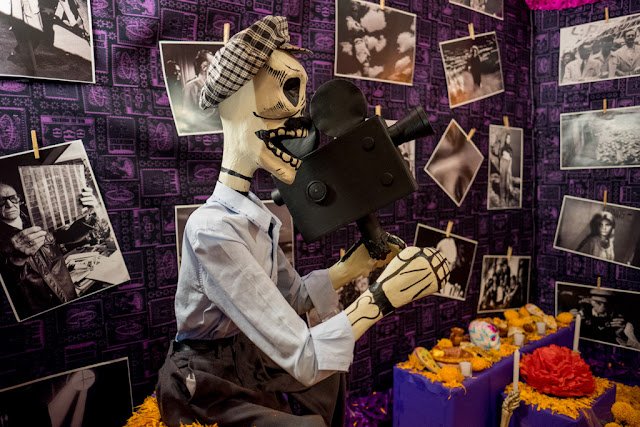
We came across this place by complete serendipity and can’t rave about it highly enough. If you ever find yourself debating to skip the long lines in front of the Frida Kahlo Museum, do so and head over to Emilio’s house. It was absolutely a fantastic experience with solely Mexican visitors around. In Emilio’s house, you’ll find myriads of lovingly exquisite altars, and may be lucky enough to attend the dance and song performances in the courtyard.
Below you’ll find a bunch of the altars with some descriptions of the elements used, but before that, let me repeat: You must definitely go and see this place for yourself. Every tiny corner of Emilio’s house is full of quirky details that you can easily spend hours admiring and inspecting them!
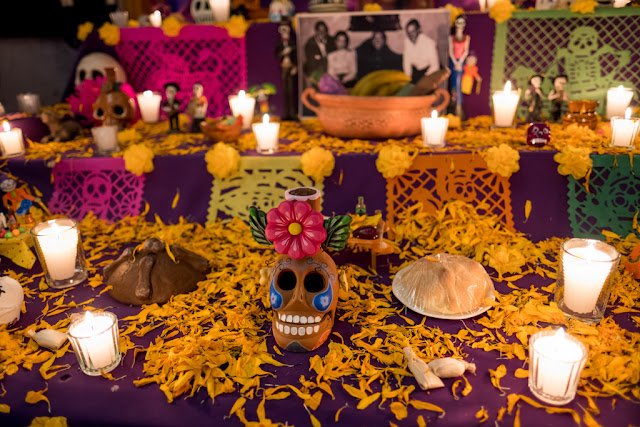
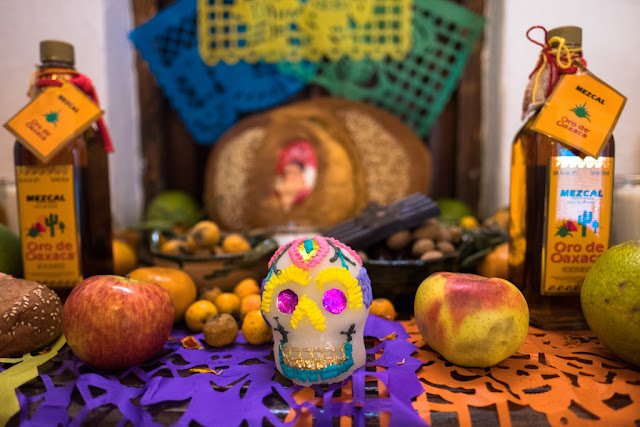

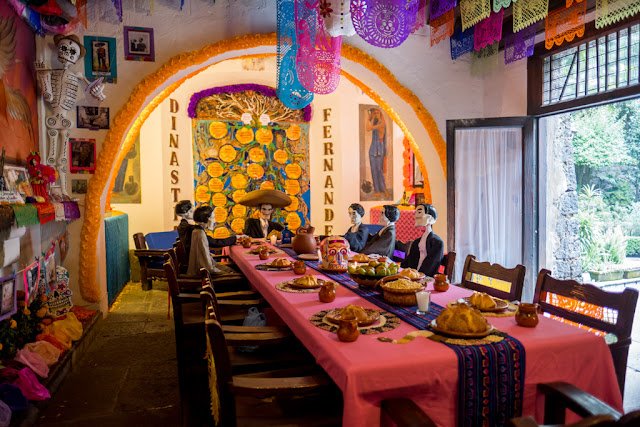
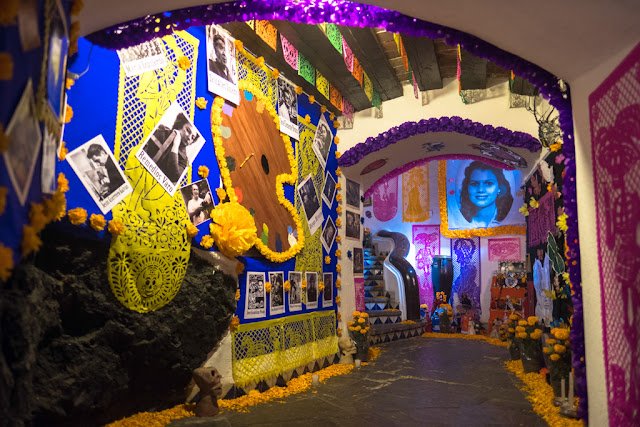
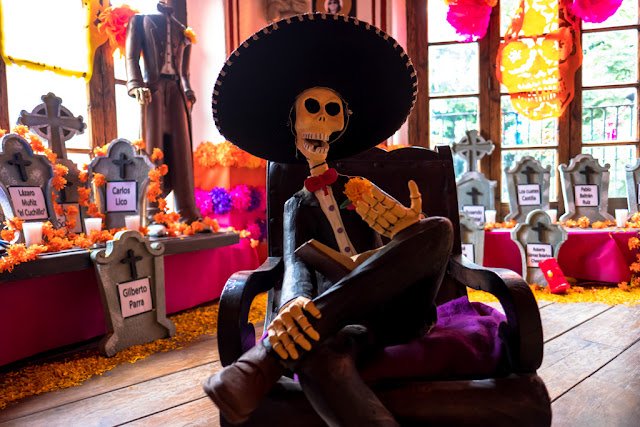
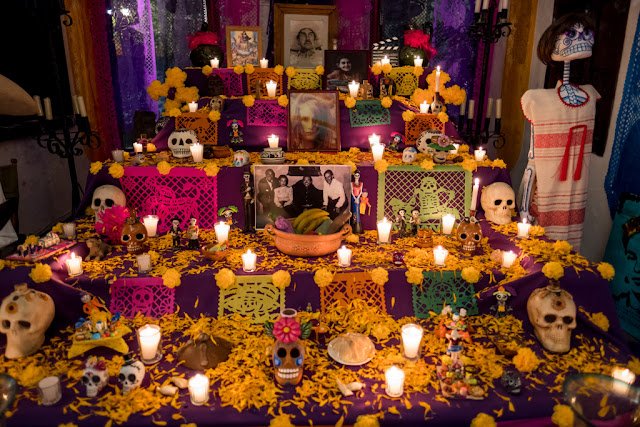
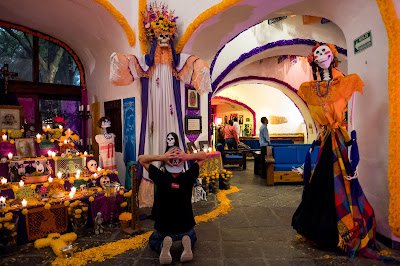

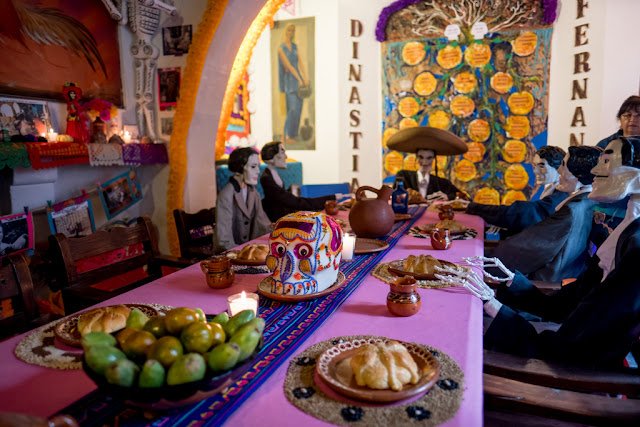


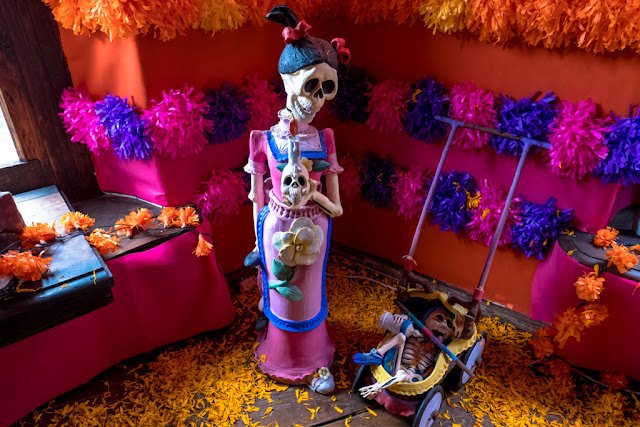
Once you are through making acquaintance with the dead celebrities, remember to check out the courtyard, where on certain evenings you’ll be able to enjoy the dance and music performances, following the motto ” celebrate life”.

Although it may not be the most professional show you’ll have seen, you’ll celebrate life for sure. Here is a clip I took back in 2018 during my visit: https://youtu.be/kdmX9yvpIFU.
Here comes another clip https://youtu.be/QujnskqPcgA involving the most famous song you’ll hear all around during Dia de Muertos: La Llorona. The legend has it that a woman who drowned her children now spends eternity crying while searching for her children.
The song, La Llorona, is featured in the Disney-Pixar animation movie Coco (2015), which is a highly recommended movie I’ve yet to watch, but I watched the 2017 release of Coco, a different story again on the topic of the Mexican Dia de Muertos. It’s worth looking for these movies in your inflight entertainment system.
Now comes the part of the performance that left me speechless, and admittingly with thin tears. In the dance of the leaves and raindrops (https://youtu.be/878BtPUKzUU), what does belly-dance and Day of the Dead have in common?
Who is La Calavera Catrina —The Skeleton Dame
La Calavera Catrina, or the elegant skull, is Day of the Dead’s one of the most ubiquitous symbols. The classy skeletal lady was first created by Mexican illustrator José Guadalupe Posada in the early 20th century to mock the indigenous Mexicans who wanted to adopt European styles. “Todos somos calaveras,” a quote encapsulating Posada’s viewpoint, means “we are all skeletons.” In all of our human-made traps, we’re all the same; the death is an equalizer of an unequal society.

You can easily come across the elegant lady all over Mexico City, but a sure-fire place would be the Zócalo or the city’s central square, which is always vibrant and has a festive display for Day of the Dead.

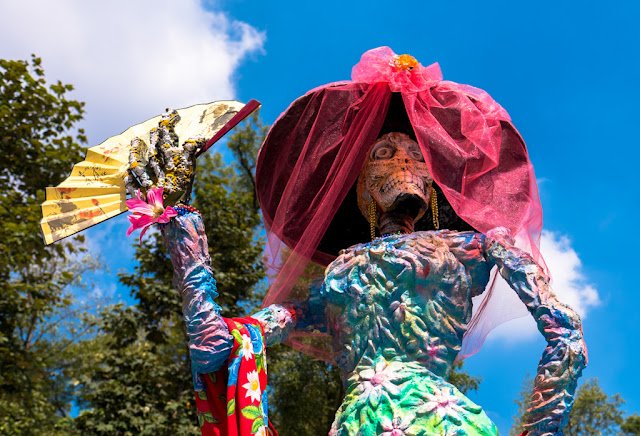
Let’s not neglect Santa Muerte —The Saint of Death
Santa Muerte, the other skeleton lady is a Mexican folk saint that personifies death in the form of a female skeleton. Unlike other saints, she is not perceived as a dead human being, she is the death herself. Santa Muerte is not to be confused with the popular Mexican image of La Catrina, which stems from a satirical cartoon.
In spite of the fact that many Mexicans see no connection between the cult of Santa Muerte and Dia de Muertos, an interplay of cultures has flowed into the Day of the Dead celebrations in recent years. Both cultures are thought to originate from the Aztec goddess of death, Mictecacihuatl, whom Aztecs dedicated a festival every August.
Altars for Santa Muerte can be found throughout Mexico City‘s historic center where devotees leave red apples, alcohol, cigarettes, flowers, and candles as offerings. Even if you are not in town during Day of the Dead, you may want to check out the Church of La Santa Muerte for your daily dose of skinny and quirky stuff.
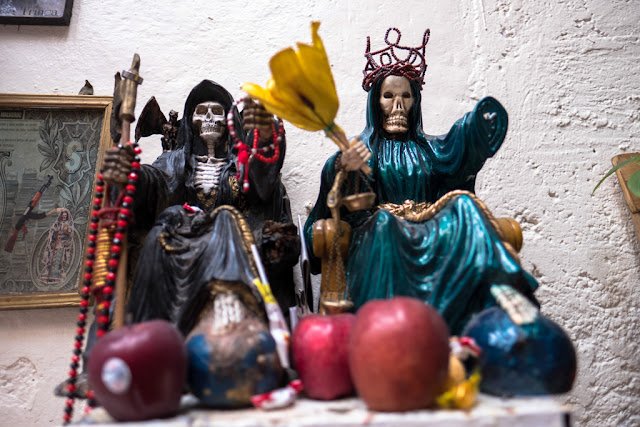
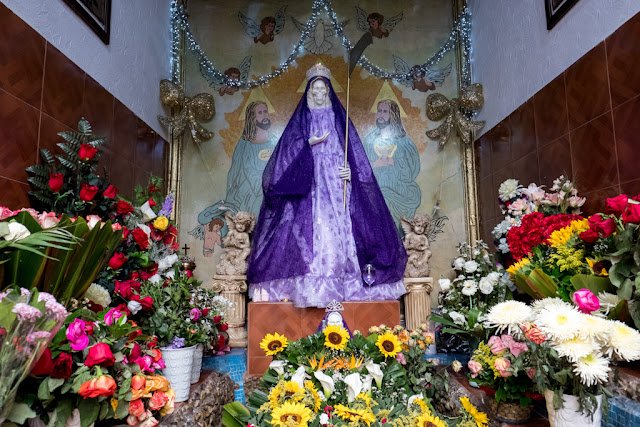
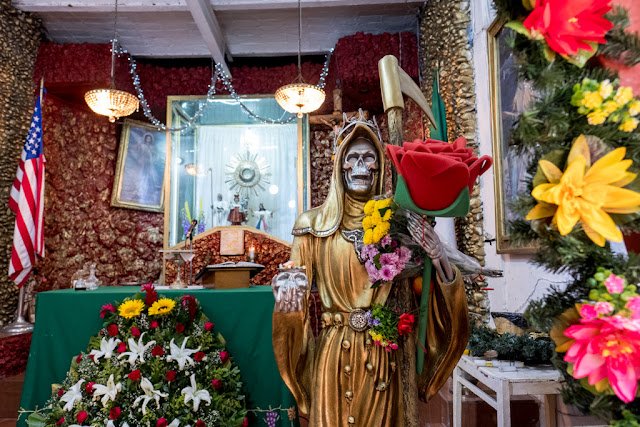
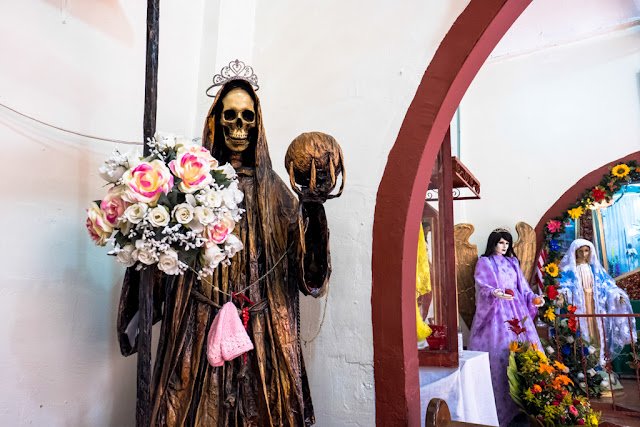

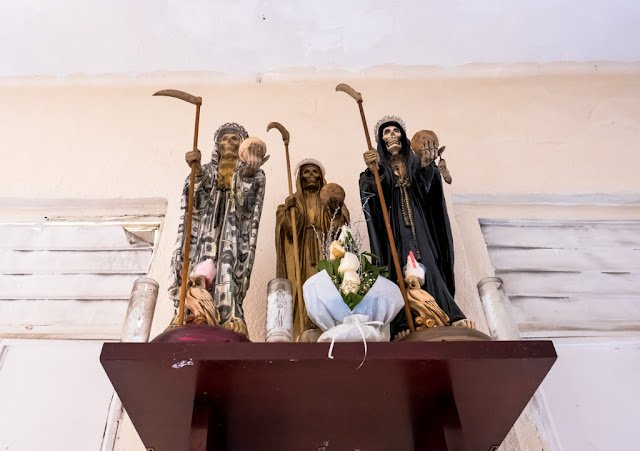

Dead, like real dead —Mummies of Museo de El Carmen
If all the fantasy-full skeletons and skulls were not enough, you may want to visit the Museo de El Carmen, a former convent in the chic neighborhood of San Ángel, to see real dead people (and as a bonus, a large collection of Mexican colonial religious art). In the crypt underneath the former school, you’ll find a dozen of mummified bodies of past parishioners.
The bodies found here are naturally mummified and in very good condition. They still look impressively handsome for passport photos, don’t you think?!
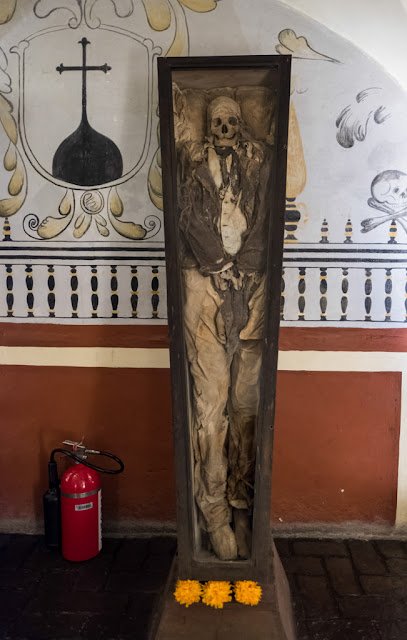
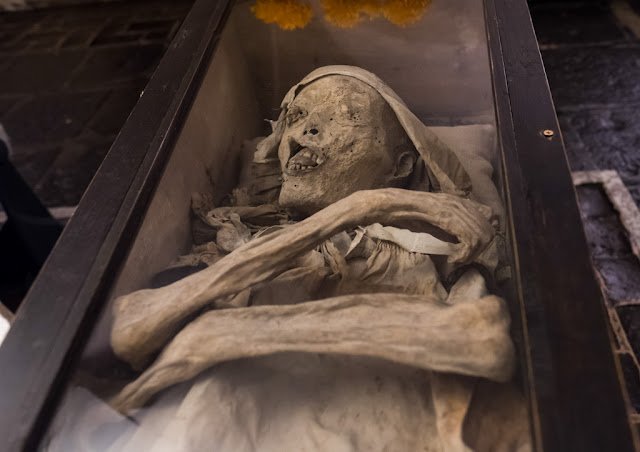
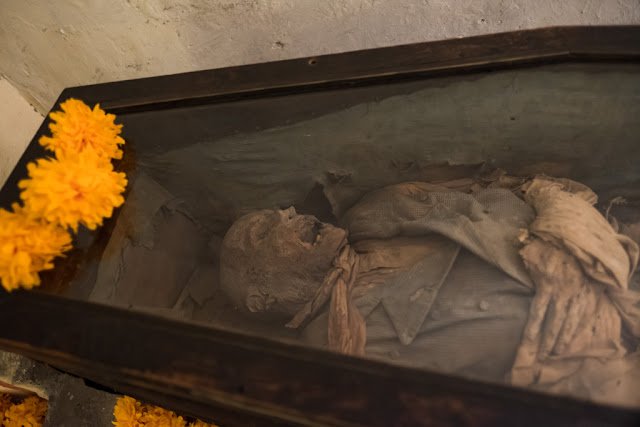
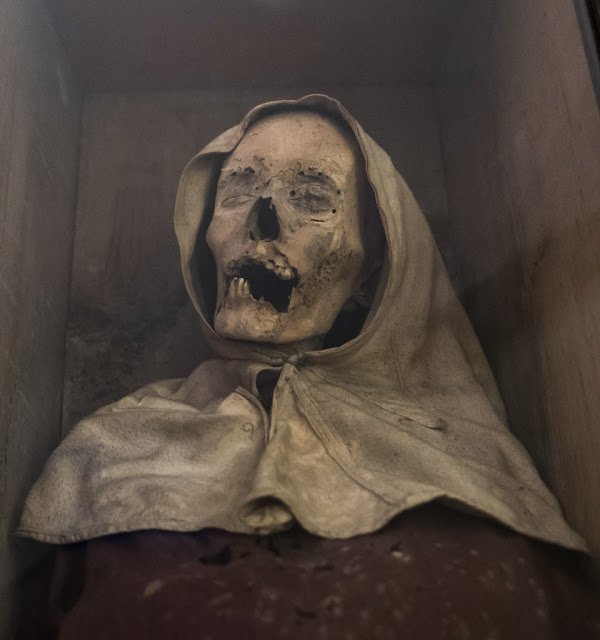
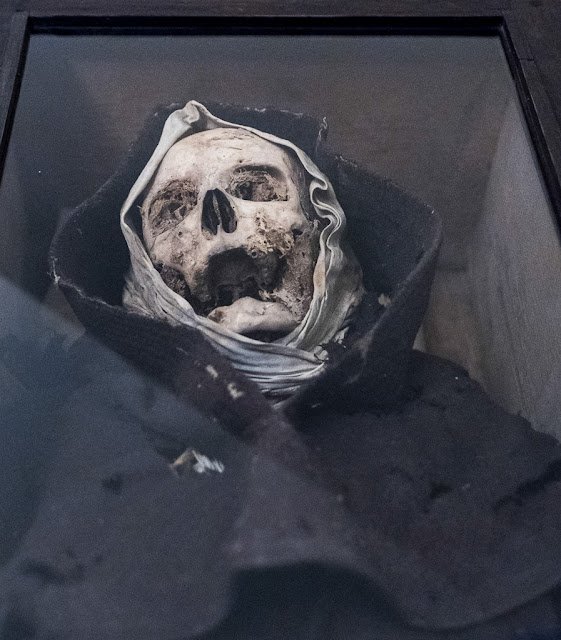


How (not) to chase Alebrijes —The Mythical Creatures
The alebrijes are imaginary colorful zoomorphic figures that combine parts from a bunch of different animals such as reptile, bird, dragon, insect, fish, and feature detailed vibrant patterns. Originally made of papier-mache, they can be nowadays carved out of wood and come in different shapes and sizes.

First created by Pedro Linares Lopez in the 1930s, alebrijes are today an integral part of Mexican folk art and are sometimes used during Dia de Muertos as decorations. Since 2007 the Museo de Arte Popular (MAP) organizes The Alebrije’s Night in Mexico City that includes a huge alebrije parade.
The Desfile de Alebrijes takes place usually two weeks before the Day of the Dead Parade and the mythical creatures remain on display along Paseo de la Reforma (Avenue Reforma) until the Day of the Dead Parade itself. I didn’t know anything about the alebrijes until I headed to Av. Reforma for the Day of the Dead Parade. But then, I couldn’t help but chase the hundreds of fantastic creatures, or more precisely, they chased me that I couldn’t hold a front-row spot for the parade.
💡 Tip: So, make sure to stroll along Paseo de la Reforma latest a day before the Day of the Dead Parade.

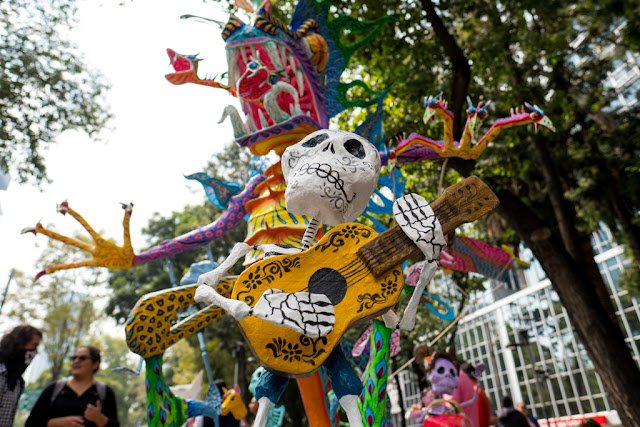

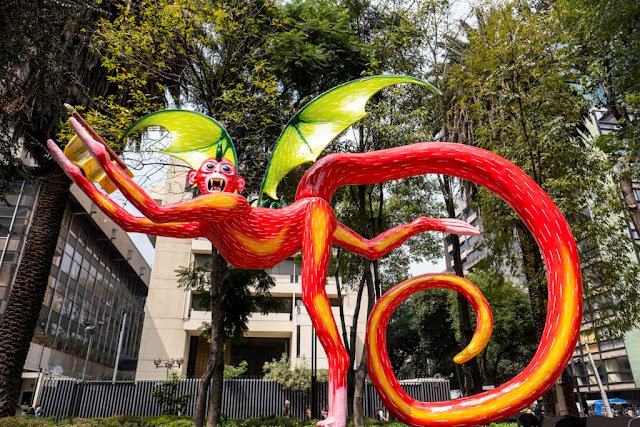
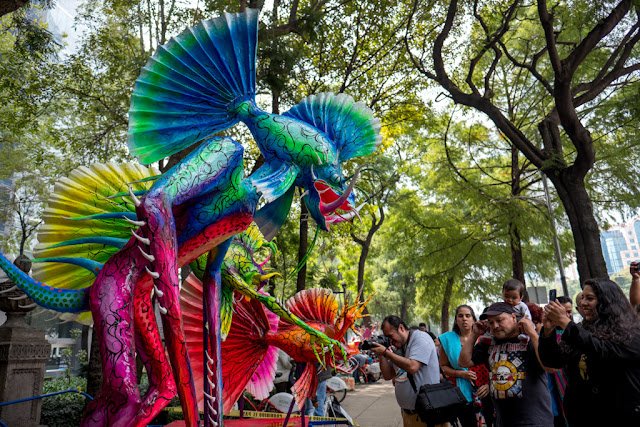

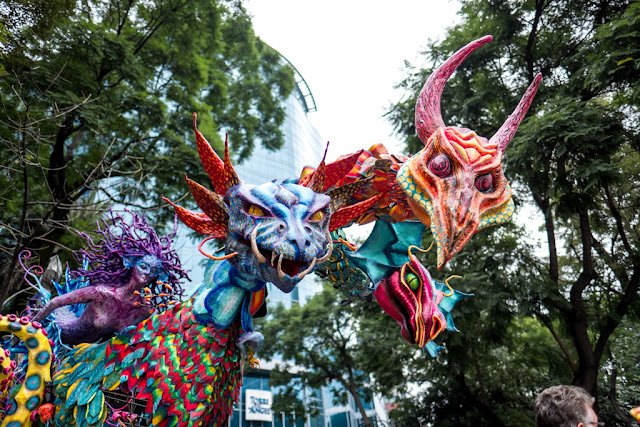
How to attend the Day of the Dead Parade in Mexico City
The Day of the Dead parade in Mexico City is a very recent, rather a commercial ‘tradition’. A parade through downtown Mexico City had never been a tradition until the James Bond movie Spectre depicted a made-up one in 2015. Bringing Bond to Mexico City was part of a project to promote the capital as a major tourism destination.
According to leaked documents, Mexican officials offered Sony Pictures millions of dollars in tax incentives in exchange for featuring the capital city in the Bond film. And guess what? That smart plan worked out. The tourists wanted to know when and where they could see the parade from the movie. So, in 2016 a Day of the Dead parade was held for the first time in Mexico City, and I was able to attend its third version in 2018.
Locally known as “Desfile de Día de Muertos,” Mexico City’s Day of the Dead parade normally precedes the actual holiday. You’ll see giant skeleton puppets, traditional dancers, spiritual cleansers, elaborate costumes, moving altar floats, beautiful catrinas and more. Just watch the parade in action in the video at this link: https://youtu.be/rNN7FjgEYNc!
📍Where The parade route begins at the Estela de Luz and continues down the Paseo de la Reforma to the Zócalo for over three miles. The parade lasts about 2 hours, usually scheduled between 4-6 pm.
💡 Tip: It’s best to find a front-row spot along the parade route at least two hours before and wait patiently. Otherwise, bring a ladder as some locals did, or you might need to learn to love rose thorns as I did. The idea with piggyback as seen in the pic below was not really comfortable😅

As I didn’t have a prime spot, my pics and videos from the parade did not turn out great at all, but obviously, there’s tons of art involved to admire. Get there before the parade gets more famous, thus much more crowded.

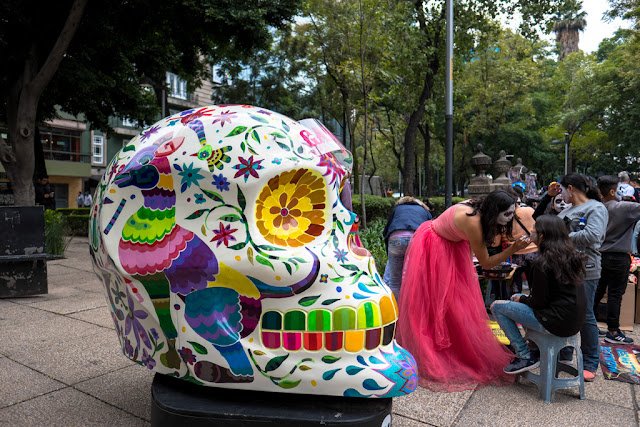
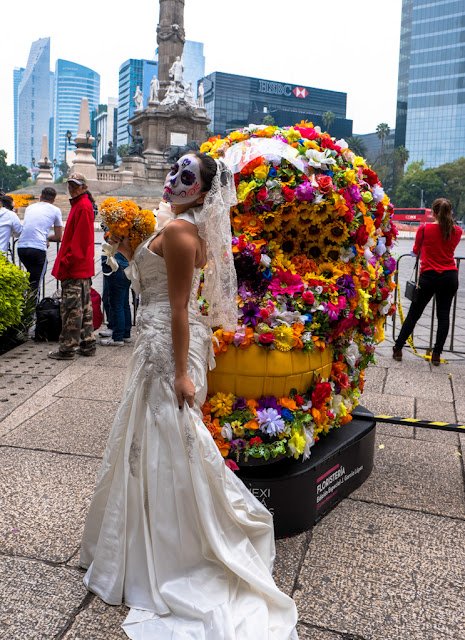
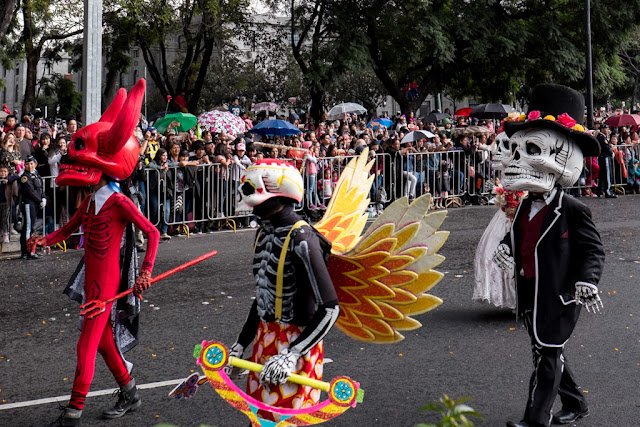
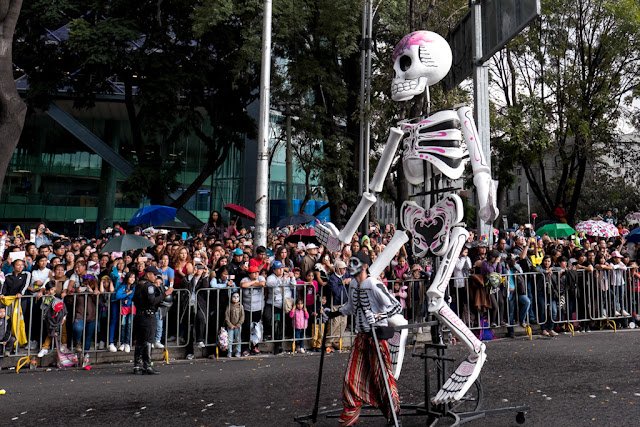
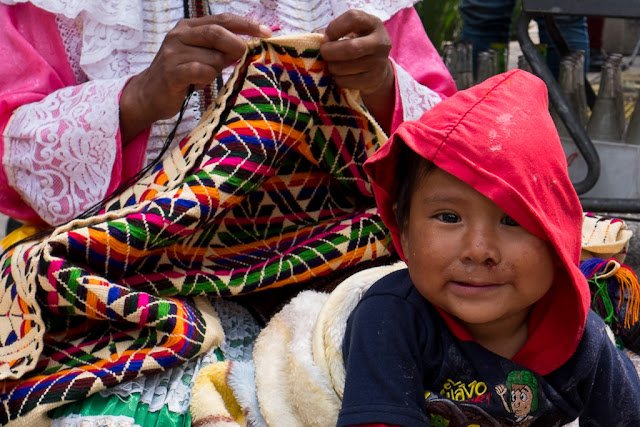
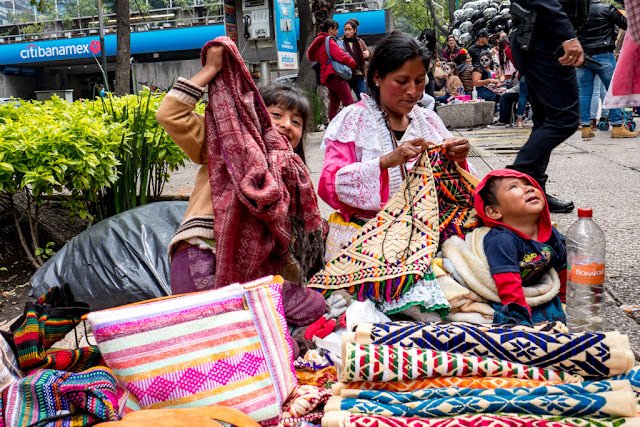
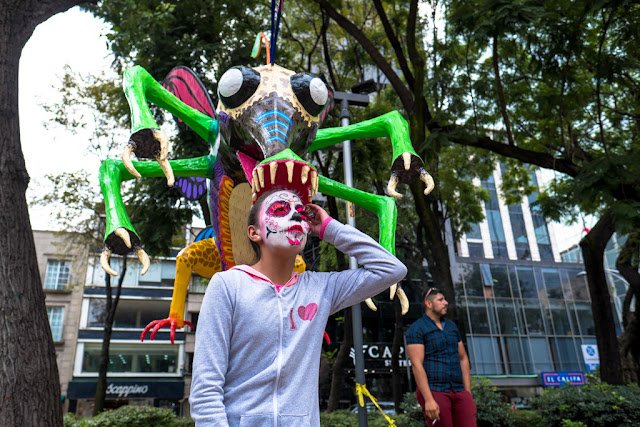
Tips on trip planning: When to see what?
It can be a bit tricky to figure out which events happen when exactly while planning your holiday around the Day of the Dead.
In summary, you should bear in mind the following points:
- Day of the Dead holiday in Mexico is celebrated for 3 days between October 31 and November 2. and each day has a specific meaning:
- October 31 is Day of the Innocents, where the spirits of deceased children are reunited with their families. They are the first to arrive to visit before the adults do, as they’re quicker on their feet.
- November 1 is All Saints Day, where the adult spirits will come to visit.
- November 2 is Day of the Dead when families go to the cemetery to decorate the graves of their loved ones.
- The celebrations in most places in Mexico start a week prior.
- Day of the Dead Parade in Mexico City is held on a Saturday, usually before the actual holidays. It’s still quite new to say it’s always held on the weekend before the actual Day of the Dead, as the Mexican officials keep changing the event date&time, but the city can keep you busy anyways for weeks even without a parade.
- Alebrijes Parade is generally held two weeks before the Day of the Dead and figures remain on display until the Day of the Dead Parade itself.
- You can view the altars and celebrations at Emilio’s House on three weekends before and after the actual Day of the Dead.
- Albeit absolutely worthwhile, Mexico City may not be the best destination for the sole purpose of partaking in traditional Day of the Dead festivities, because the celebrations here are rather commercial, e.g. no celebrations at cemeteries. Perhaps the most traditional celebration near Mexico City takes place at San Andres Mixquic cemetery, located 1.5 hours southeast of Mexico City on the night of November 1st when all the local families get together and wait for their beloved ones to arrive.
Important Event Dates for Day of the Dead in Mexico City 2024
In 2024, these three days of Día de Muertos, October 31-November 2 falls on a Thursday, Friday, and Saturday. The Day of the Dead parade may potentially be held on Saturday, October 26. Unfortunately, the date-specific information is often not released until early September. Once released, I’ll update the information here. So for now, to give you an idea, the dates might be as follows:
- In 2018 when I visited 31st of October fell on a Wednesday, and the Day of the Dead Parade was held on Saturday, October 27, 2018. In 2019, the parade was on November 2, which happened to fall on a Saturday after the actual holiday. In prior years, the Dia de Muertos parade in Mexico City was held on the Saturday before November 2.
- I met the Alebrijes by chance on the same day as the Day of the Dead parade. The next day, i.e. on Sunday they were gone. In 2024, we can presume that they will be on display until November 2nd, and the Alebrijes parade would possibly be held on October 19.
- I was able to join the event at Casa de Emilio on Friday, October 26, 2018 (which was open till November 18, 2018). You may want to contact them on Facebook for the current dates.

The aforementioned dates for 2018 gave me the opportunity to visit Oaxaca City from October 30 to November 2, which in turn allowed ample time to join the traditional comparsas, carnival-like processions of people in costumes, with music and dancing, every day and night, almost non-stop. The events in Oaxaca City were scheduled from October 28 to November 4, 2018. You can find the details of the celebrations in Oaxaca City in the next post.
Bottomline
A final thought to help you make up your mind: Although I wouldn’t want to miss any of the experiences in Mexico City, and I do love Mexico City so much that I’d like to live there for a while in the future, for the sole purpose of Dia de Muertos celebrations, I’d plan to spend the main holidays in Oaxaca City, i.e. roughly from October 30 to November 2, and see if you are lucky enough to hit one or the other stuff in Mexico City either before or after these dates.
The comparsas in Oaxaca City are so much fun, you can visit cemeteries, actually experience everything in one place. If you can’t fit both cities in one vacation, make sure to spend another and another holiday in Mexico, simply because it’s a magical country, let alone Day of the Dead is worth many visits.
Bonus Event — Lucha Libre Wrestling
If you need a break from skulls and skeletons, a super fun spectacle in Mexico City is Lucha Libre (freestyle wrestling), lots of laughter guaranteed. It’s as Mexican as tacos and cactus, and should not be missed if you are around on a Tuesday, Friday or Sunday night.

Sunday is the family fun day as the event starts early at 5 pm. The most excellent action is said to happen on Friday nights but you will need to get there early to get prime seats. We got to the Arena half an hour before the event on a Sunday and bought tickets for the first row (~15 EUR/pp). The fight continues sometimes outside the ring and we were right there in the middle of the action. BTW, the fight is carefully choreographed, nobody gets hurt.
Cameras apart from cell phones are not allowed, so leave any kind of system/DSLR cameras at home, otherwise, they’ll take and keep it safe during the show. The neanderthal guy in the video I shared here on my Instagram page shouted right into my phone’s camera not to take any photos🤣
In any case, it is a brilliant event I’d highly recommend attending while in Mexico City.
See you next in Oaxaca City!

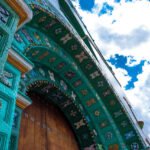
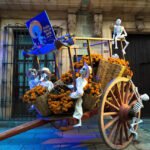


[…] The Holy Guide to Death and Day of the Dead in Mexico City […]